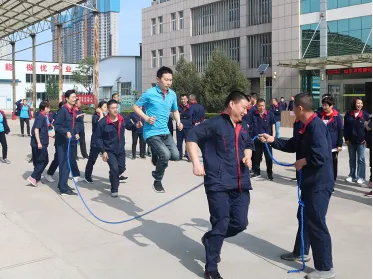Climbing rope
Rope used to secure climbers
This article is about rope used in mountaineering and sport climbing. For the gymnastic activity, see Rope climbing
A climber and a belayer using a climbing rope
A climbing rope is a rope that is used in climbing. It is a critical part of an extensive chain of protective equipment (which also includes climbing harnesses, anchors, belay devices, and carabiners) used by climbers to help prevent potentially fatal fall-related accidents.
Climbing ropes must meet very strict requirements so that they do not break in the event of an accidental fall. However, they also need to be light, flexible for knotting, and resistant to chafing over sharp and rough rocks; all that in all possible weather conditions. Although ropes made of natural fibres such as hemp and flax were used in the early days of alpinism,[1] modern climbing uses kernmantle ropes made of a core of nylon or other synthetic material and intertwined in a special way, surrounded by a separate sheath woven over it. The main strength of the rope is in the core, and the sheath of the rope represents only a small fraction of the overall strength of the rope.
Climbing ropes can be classified into three categories according to their elasticity: static, semi-static, and dynamic ropes.
Static rope
Static ropes are ropes that are specifically designed for little or no stretch. As a result, they are unable to absorb large shocks. They should therefore not be used to protect a climber against a fall. On the other hand, they are particularly strong and can withstand a large load under static load. They find their application in fixed ropes, zip lines and shuttles.
Semi-static rope
Semi-static ropes have limited stretch. They can absorb small shocks and are also statically loaded yet very strong. However, these ropes may not be used to protect climbers from falling. They are used as fixed ropes, for rescue operations, and in caving.
Dynamic rope
Dynamic ropes are used in sport climbing. They are sufficiently stretchable to safely absorb a fall. However, they are relatively weak in static loads and therefore should not be used for zip lines and amusement rides.
A falling climber quickly develops enormous kinetic energy. This energy is released as soon as the climber stops falling. Some of this energy goes to the belay chain, the rest is split between the belayer and the climber. The rigid parts of the belay chain are strong, but only absorb a limited amount of energy. The human body can also only handle a limited amount of force on the body (the so-called catch or impact value) without incurring a back injury. Dynamic ropes therefore are designed to stretch by a limited amount to catch falls. By stretching, a large part of the energy generated is captured so that the final capture impulse for a single rope is less than 12 kN, under testing conditions as defined in the CE standards.[2] UIAA rules mandate that stretching be less than 40%.[3]
Dynamic ropes can be single ropes, half ropes, and twin ropes, each with different specifications.[4]
Dry rope
Dry ropes are ropes that have been treated to repel water. To achieve a UIAA Water Repellent grade, a rope must not absorb more than 5% of the rope's weight.[5] This is in contrast to non-treated ropes which can absorb up to 50% of rope's weight in water.[6]
The dry treatment prevents dirt and other particulates from getting into the rope, extending the rope life. However, the dry treatment will wear off with extended use.[2] Dry ropes are more expensive than non-treated ropes, so they are typically saved for ice climbing or wet weather.
Maintenance
Ropes must be inspected regularly, and retired from use if significantly damaged or worn.[7]
Climbing rope
Rope used to secure climbers
This article is about rope used in mountaineering and sport climbing. For the gymnastic activity, see Rope climbing
A climber and a belayer using a climbing rope
A climbing rope is a rope that is used in climbing. It is a critical part of an extensive chain of protective equipment (which also includes climbing harnesses, anchors, belay devices, and carabiners) used by climbers to help prevent potentially fatal fall-related accidents.
Climbing ropes must meet very strict requirements so that they do not break in the event of an accidental fall. However, they also need to be light, flexible for knotting, and resistant to chafing over sharp and rough rocks; all that in all possible weather conditions. Although ropes made of natural fibres such as hemp and flax were used in the early days of alpinism,[1] modern climbing uses kernmantle ropes made of a core of nylon or other synthetic material and intertwined in a special way, surrounded by a separate sheath woven over it. The main strength of the rope is in the core, and the sheath of the rope represents only a small fraction of the overall strength of the rope.
Climbing ropes can be classified into three categories according to their elasticity: static, semi-static, and dynamic ropes.
Static rope
Static ropes are ropes that are specifically designed for little or no stretch. As a result, they are unable to absorb large shocks. They should therefore not be used to protect a climber against a fall. On the other hand, they are particularly strong and can withstand a large load under static load. They find their application in fixed ropes, zip lines and shuttles.
Semi-static rope
Semi-static ropes have limited stretch. They can absorb small shocks and are also statically loaded yet very strong. However, these ropes may not be used to protect climbers from falling. They are used as fixed ropes, for rescue operations, and in caving.
Dynamic rope
Dynamic ropes are used in sport climbing. They are sufficiently stretchable to safely absorb a fall. However, they are relatively weak in static loads and therefore should not be used for zip lines and amusement rides.
A falling climber quickly develops enormous kinetic energy. This energy is released as soon as the climber stops falling. Some of this energy goes to the belay chain, the rest is split between the belayer and the climber. The rigid parts of the belay chain are strong, but only absorb a limited amount of energy. The human body can also only handle a limited amount of force on the body (the so-called catch or impact value) without incurring a back injury. Dynamic ropes therefore are designed to stretch by a limited amount to catch falls. By stretching, a large part of the energy generated is captured so that the final capture impulse for a single rope is less than 12 kN, under testing conditions as defined in the CE standards.[2] UIAA rules mandate that stretching be less than 40%.[3]
Dynamic ropes can be single ropes, half ropes, and twin ropes, each with different specifications.[4]
Dry rope
Dry ropes are ropes that have been treated to repel water. To achieve a UIAA Water Repellent grade, a rope must not absorb more than 5% of the rope's weight.[5] This is in contrast to non-treated ropes which can absorb up to 50% of rope's weight in water.[6]
The dry treatment prevents dirt and other particulates from getting into the rope, extending the rope life. However, the dry treatment will wear off with extended use.[2] Dry ropes are more expensive than non-treated ropes, so they are typically saved for ice climbing or wet weather.
Maintenance
Ropes must be inspected regularly, and retired from use if significantly damaged or worn.[7]
How Climbing Ropes Are Made (at Edelrid)
Earlier this year we travelled to Germany and toured Edelrid’s headquarters and rope making facility. We asked them to walk us through every step of the rope making process and we’re sharing those details below. It’s surprising to see how much each step of the process influences and shapes the final characteristics of the rope. During our multiple visits to their factory, Edelrid surpassed even our most exaggerated view of what stereotypical “German Engineering” could mean.
Raw material sourcing is where it starts
All modern climbing ropes are made from the same basic material, nylon (aka polyamide) yarn. Edelrid has gone through significant effort to make sure the nylon yarn they source for all of their ropes is bluesign® certified. Because of their strict performance and environmental requirements, there are only 1 or 2 suppliers in the world that can manufacture and certify the materials needed to make their ropes.
The nylon yarn that goes into ropes is made up of ultra thin filaments that are thinner than a strand of hair. In one sheath yarn there are 135 super fine filaments. A little thicker than the sheath yarns, the core yarn contains over 200 filaments.
Twisting the yarn
The core yarns arrive at Edelrid already twisted together in pairs. The sheath yarns are twisted together by Edelrid and the twisting of the sheath yarns accomplishes two things: It simultaneously makes the yarn more dynamic because it can act like a spring, and it increases the abrasion resistance of the final rope. Edelrid twists their sheath fibers between 110 and 130 times per meter. Although the core yarns are always twisted in pairs, sheath yarns are twisted in groups of 2, 3, 4 or 5 depending upon the characteristics of the final rope. These twisted groups make up the fibers that get braided together to form the sheath. Generally speaking, increasing the number of yarns that are twisted together results in a thicker sheath.
Readying the rope for the autoclave
After the sheath yarn is twisted, the sheath fibers must be taken off the spools and loosely knit, then hung on racks before it goes into the autoclave. The twisted core yarns are too thick to knit together so they get wound into loose coils and hung on racks.
These processes ensure that all of the yarn is shrunk and heated evenly inside the autoclave. The autoclave has 15 different shrinking programs that manipulate the temperature, pressure, humidity, and sometimes add chemicals, for precise periods of time. Edelrid told us that this shrinking process is the most critical step as it enables Edelrid to precisely manipulate the characteristics of the raw material for each particular rope. The sheath and core fibers are subjected to the same shrinking process to ensure that they behave similarly together throughout the lifespan of the rope. In the autoclave, the fibers are shrunk up to 30%.
De-knitting the yarns
After the sheath yarns are shrunk in the autoclave, these yarns must be de-knit and put back onto bobbins, also known as carriers, that are used on the braiding machines. Similarly, the core yarns are wound back onto spools.
Core dry treatment (optional)
After the shrinking process, if the rope is going to be a dry-treated rope, the core yarns are sent through a machine that applies the water repellent treatment. This process also adds a small amount of red dye, which is used to easily identify if it’s a dry treated core or not but does not change the performance.
Humidity Control
Because nylon is actually quite susceptible to temperature and humidity changes, a rope that is braided in a hot and humid environment will actually perform and handle differently than a rope braided in a cool and dry environment, all other factors being the same. To ensure maximum consistency in their products, Edelrid’s factory is temperature and humidity controlled to ensure the yarn is braided under the same environmental conditions regardless of the weather outside.
Braiding the rope
Although most manufacturers buy the same braiding machines, Edelrid significantly modifies each machine before it goes into production. Edelrid has 6 full time employees in their shop that work to calibrate, customize, and repair the braiding machines.
During the braiding process there are five main factors that change the handling and durability of the rope.
- The number of carriers (bobbins) on the machine
- The tension of the yarn
- The angle of the braiding
- The speed at which the rope is being pulled through the machine relative to how quickly the bobbins are braiding
- The diameter of the hole the rope is being pulled through
All these processes are balanced to create a consistent outcome. For example, the sheath braid becomes tighter and the rope becomes stiffer as either the braiding angle increases, the diameter of the hole decreases, or the tension on the yarn increases.
The number of carriers (bobbins on the machine)
For braiding, there are 2 main types of machines used for making dynamic ropes, a 40-carrier (40-bobbin) and a 48-carrier machine. By using the 48-carrier machine, it’s possible to make a rope that has a flatter, smoother sheath. All other things being equal, the 48-carrier will give the rope a thicker sheath because there is more yarn being braided which often results in more durability. But these ropes also tend to be more expensive because the 48-carrier machine is less efficient for manufacturing because of its larger size and slower braiding speed.
Getting dirty in the details: It is actually possible to create ropes of the same diameter and sheath proportion on each machine, but for this to happen the sheath yarns used on the 40-carrier machine will need to be made of thicker fibers made of more twisted yarns.
Sheath dry treatment (optional)
If the rope is an Edelrid “Pro” dry rope, it already had the core treated earlier in the process, and now the rope will run through a dry treatment coating the sheath. This involves submerging the entire rope in a bath of waterproofing fluid, curing the treatment, and then drying and cooling. This “double dry” treatment that coats the sheath and core allows Edelrid’s ropes to pass the UIAA certifications of a “Dry” rope.
What’s most interesting about this part of the process is when the sheath is treated, it also completely changes the handling of the rope. Before the rope is treated it feels stiff, and after the treatment process it feels smooth and more flexible.
This must be taken into account when designing the rope, especially when there are dry and non-dry versions. The raw fibers end up going through a completely different set of processes in the autoclave and on the braiding machine. This ensures that the final products have the same handling characteristics despite one being treated and the other not.
Inspection, cutting, middle mark, and packaging
Typically Edelrid produces about 1000 meters of rope per production run on the braiding machines. After braiding, if the rope is a non-dry rope, it is nearly complete and goes to inspection. Otherwise, inspection happens after the dry treatment process. Either way, every meter is run through an inspector’s hands. This by-hand inspection is done to make sure there are no tactile or handling deviations throughout the entire rope.
If the rope passes the hand inspection, it is then sent through a machine that cuts the rope to the proper length and applies the middle mark. As the rope comes out of the middle marking machine, a person inspects the painted mark to ensure that it is fully complete and if it is not, they finish painting the middle mark by hand. They then melt the rope ends and tape the terminations by hand. The rope is then coiled and packaged for delivery.
Starting in the summer of 2017, Edelrid has also begun coiling their ropes using their newest invention, the 3D Lap Coil machine. This patented machine quickly coils a rope so that it eliminates kinks when uncoiling for the first time, making it possible to belay straight out of the package. Other companies have offered their ropes in a lap coil straight from the factory, but this requires a super expensive robotic arm. Edelrid invented and developed a much more economical version and these savings are passed on to the consumer. There is no increase in price even with the added benefit of the 3D Lap Coil.
That’s it!
In an overview sense, the process for most rope manufacturers is comparable. Most rope manufacturers are starting with similar (and at times, literally the same) raw fibers. And, most of the braiding machines are sourced from the same manufacturer. But the nuances and differences start to add up quickly between each rope manufacturer and their preferred processes. A story for another post!










